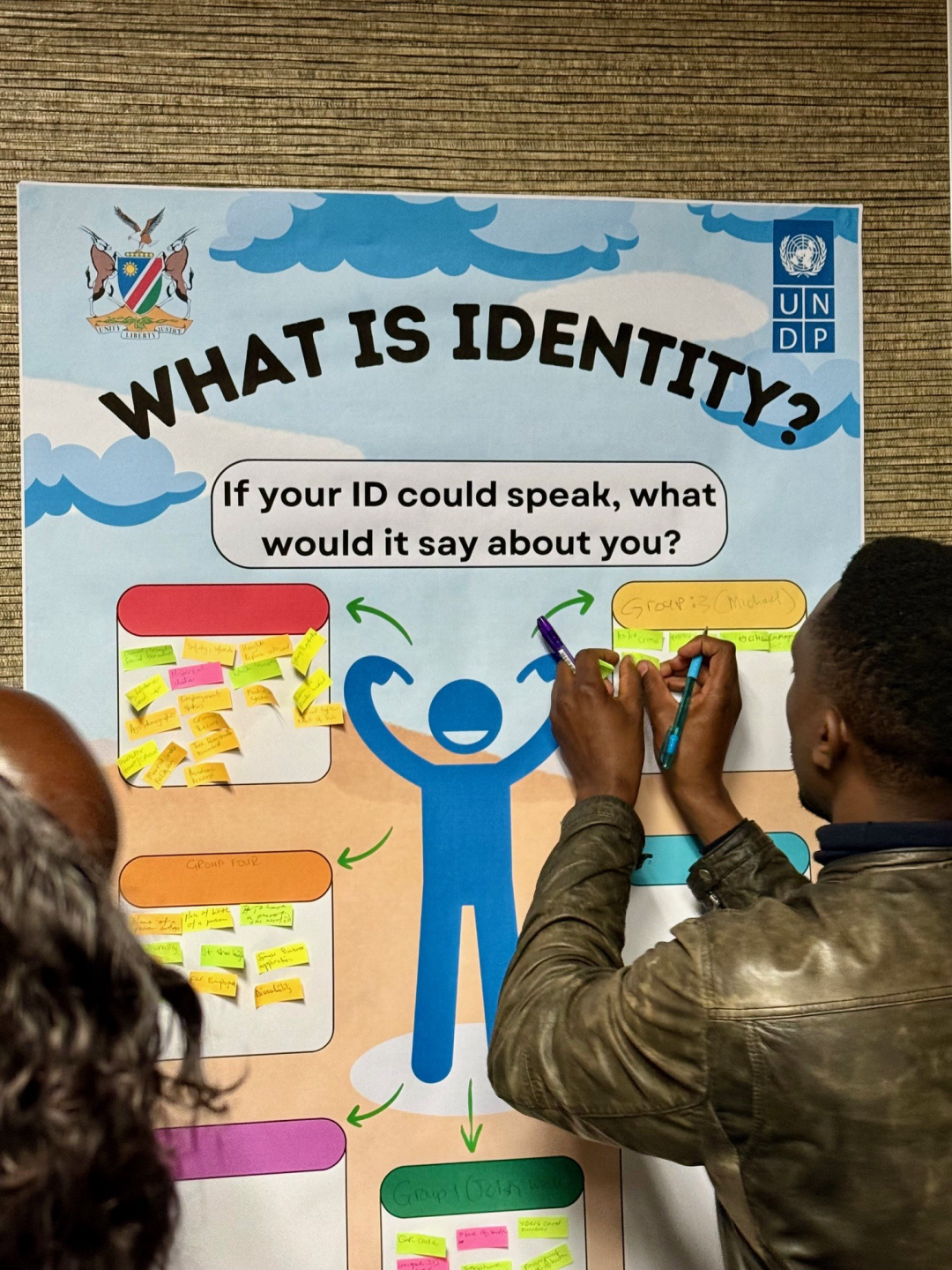Disclaimer:
Please be aware that the content herein has not been peer reviewed. It consists of personal reflections, insights, and learnings of the contributor(s). It may not be exhaustive, nor does it aim to be authoritative knowledge.
Learnings on your challenge
What are the top key insights you generated about your learning challenge during this Action Learning Plan? (Please list a maximum of 5 key insights)
1. Digital transformation is a governance journey, not a technical rollout.
Namibia’s e-ID and AI ecosystem work revealed that transformation requires aligning values, capacities, and institutional trust before digital systems can scale. The e-ID effort using UNDP's model governance framework for Digital Legal Identity became a platform for re-imagining how the State relates to citizens. through identity, service delivery, and data ethics.
2. Experimentation is essential in low-certainty, high-stakes systems.
Through the Accelerator Lab, prototypes such as the AI Policy Sprint, Digital Legal Identity Mobile-ID prototype and Language Model Crowdsourcing Initiative to support onboarding on the eID provided safe spaces for government teams to “test before they invest.” This proved critical in reducing resistance and accelerating learning loops between policymakers and innovators.
3. AI and data governance require narrative legitimacy as much as technical rigor.
Public trust in digital systems depends on transparent communication, ethical framing, and participatory co-design. The e-ID Unconference and the AI Ethics & Integrity dialogues demonstrated how social listening and participatory data can humanize abstract technologies.
4. Systems value emerges at the intersection of unusual partnerships.
By bridging ministries (OPM, MICT, MHAISS), academia (NUST Tech Hub, The Omenja Yehinga Organisation, the National Art Gallery of Namibia), and private sector (Communications Regulatiry Authority of Namibia), the Lab helped the UNDP Country Office act as a neutral integrator, building shared architectures rather than competing projects.
5. Mastery across the Explorer–Experimenter–Mapper triad enables institutional learning. Each Lab member is expected to master all three roles, and through this learning expereince I was able to add value by mapping digital ecosystems (explorer), testing AI and e-ID prototypes (experimenter), and synthesizing systemic insights (mapper) to create a holistic capability for sensing, shaping, and stewarding Namibia’s digital public infrastructure agenda.
Considering the outcomes of this learning challenge, which of the following best describe the handover process? (Please select all that apply)
Our work has led to a significant change in public policy at a national or local level, Our work has been picked up by UNDP or the government and has now expanded geographically in our country, Our work has been picked up by UNDP or the government and has now expanded geographically to another country, Our work has not yet scaled
Can you provide more detail on your handover process?
The handover anchors the digital transformation and AI portfolio within the Ministry of Home Affairs, Immigration, Safety and Security, the Office of the Prime Minister supported by UNDP’s Governance Team (BBPS) and AI and Digital Transformation Unit. Key learning assets such as the Digital Legal Identity Governance Report, the AI for Governance Concept Note, and the Toolkit on Ethics and Integrity incorporating AI have been shared with OPM and MHAISS to inform 2026 programming.
Parallelly, institutional knowledge has been transitioned to NUST’s Tech Innovation Hub, ensuring continuity in research, sandboxing, and academic collaboration. This dual handover (policy + innovation ecosystem) ensures sustainability beyond the Lab’s closure.
Please paste any link(s) to blog(s) or publication(s) that articulate the learnings on your frontier challenge.
Data and Methods
Relating to your types of data, why did you chose these? What gaps in available data were these addressing?
Ethnographic data from citizen listening and community labs (Otjimbingwe, Groot Aub).
Sentiment and perception data from e-ID UNConference. Crowdsourced linguistic data for Namibian language AI platform. Institutional workflow and policy mapping data for AI policy co-creation.
Why was it necessary to apply the above innovation method on your frontier challenge? How did these help you to unpack the system?
Conventional administrative data failed to capture the lived realities and social trust dynamics around digital identity and AI. We needed data that reflects how people feel, how systems behave, and where innovation friction exists. These new data sources filled critical gaps in understanding adoption barriers and ethical risks in digital governance.
The Innovation Methods Actually Used
Systems mapping and sensemaking (digital ecosystem map for e-ID and DPI).
Behavioral insights and ethnographic listening.
Rapid prototyping and sandbox testing.
AI foresight sprints and participatory design workshops.
Crowdsourcing and data storytelling.
Why These Methods Were Necessary
The frontier challenge, governing AI and digital identity inclusively sits in a complex adaptive system. Linear planning methods failed to predict citizen behaviour, institutional resistance, and emerging risks. Systems mapping clarified relationships; ethnography revealed trust patterns; and experimentation accelerated feedback between design and policy.
Partners
Please indicate what partners you have actually worked with for this learning challenge.
Please state the name of the partner:
The Ministry of Home Affairs, Immigration, Safety and Security
What sector does your partner belong to?
Government (&related)
Please provide a brief description of the partnership.
Ministry of Home Affairs, Immigration, Safety and Security (Government): Technical anchor for e-ID implementation.
Is this a new and unusual partner for UNDP?
Yes
Please indicate what partners you have actually worked with for this learning challenge.
Please state the name of the partner:
The Office of the Prime Minister
The Office of the Vice President: Division for Marginalised Groups
The Erongo Regional Council
What sector does your partner belong to?
Government (&related)
Please provide a brief description of the partnership.
Office of the Prime Minister (Government): Policy leadership on AI and public service innovation.
Is this a new and unusual partner for UNDP?
No
Please indicate what partners you have actually worked with for this learning challenge.
Please state the name of the partner:
The Ministry of Information and Communication Technology
End
Bonus question: How did the interplay of innovation methods, new forms of data and unusual partners enable you to learn & generate insights, that otherwise you would have not been able to achieve?
The convergence of participatory data, systems innovation, and cross-sector partnerships transformed UNDP’s role from project implementer to system convenor.
This interplay produced insights impossible through traditional means: how public servants interpret AI ethics; how rural citizens perceive digital identity; how universities can host live policy sandboxes; and how global AI discourse can be localized through storytelling and co-creation.
This integrative practice positioned Namibia’s Accelerator Lab as a continental reference point for Positive Digital Development, demonstrating that inclusive governance, not technology alone, defines the success of digital transformation.
Please upload any further supporting evidence / documents / data you have produced on your frontier challenge that showcase your learnings.
The closing form saves automatically or via the blue "save changes" button the top left. Thank you



Comments
Log in to add a comment or reply.